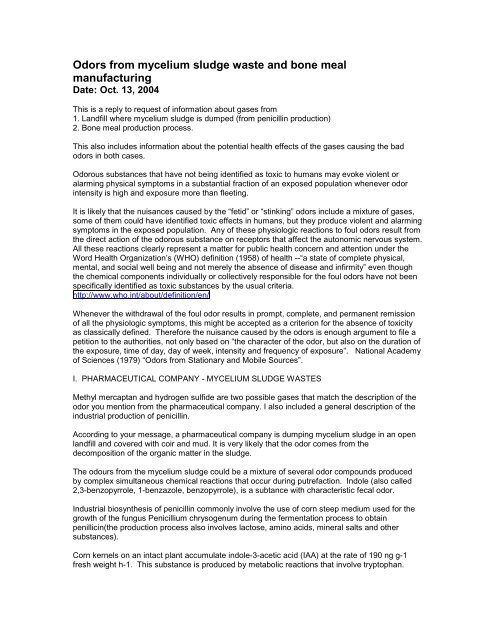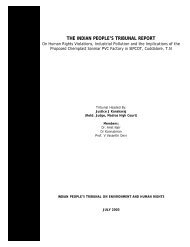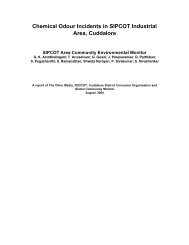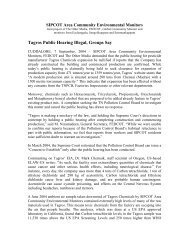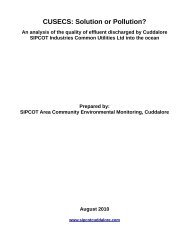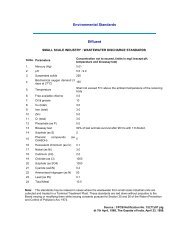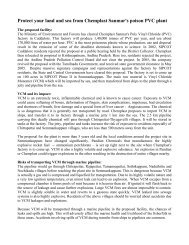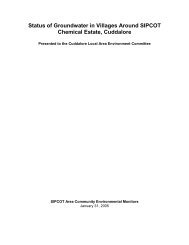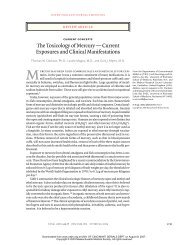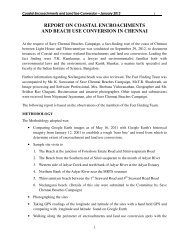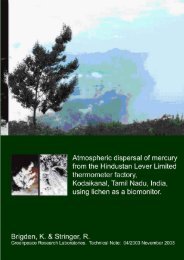Odors from mycelium sludge waste and bone meal manufacturing
Odors from mycelium sludge waste and bone meal manufacturing
Odors from mycelium sludge waste and bone meal manufacturing
You also want an ePaper? Increase the reach of your titles
YUMPU automatically turns print PDFs into web optimized ePapers that Google loves.
<strong>Odors</strong> <strong>from</strong> <strong>mycelium</strong> <strong>sludge</strong> <strong>waste</strong> <strong>and</strong> <strong>bone</strong> <strong>meal</strong><br />
<strong>manufacturing</strong><br />
Date: Oct. 13, 2004<br />
This is a reply to request of information about gases <strong>from</strong><br />
1. L<strong>and</strong>fill where <strong>mycelium</strong> <strong>sludge</strong> is dumped (<strong>from</strong> penicillin production)<br />
2. Bone <strong>meal</strong> production process.<br />
This also includes information about the potential health effects of the gases causing the bad<br />
odors in both cases.<br />
Odorous substances that have not being identified as toxic to humans may evoke violent or<br />
alarming physical symptoms in a substantial fraction of an exposed population whenever odor<br />
intensity is high <strong>and</strong> exposure more than fleeting.<br />
It is likely that the nuisances caused by the “fetid” or “stinking” odors include a mixture of gases,<br />
some of them could have identified toxic effects in humans, but they produce violent <strong>and</strong> alarming<br />
symptoms in the exposed population. Any of these physiologic reactions to foul odors result <strong>from</strong><br />
the direct action of the odorous substance on receptors that affect the autonomic nervous system.<br />
All these reactions clearly represent a matter for public health concern <strong>and</strong> attention under the<br />
Word Health Organization’s (WHO) definition (1958) of health --“a state of complete physical,<br />
mental, <strong>and</strong> social well being <strong>and</strong> not merely the absence of disease <strong>and</strong> infirmity” even though<br />
the chemical components individually or collectively responsible for the foul odors have not been<br />
specifically identified as toxic substances by the usual criteria.<br />
http://www.who.int/about/definition/en/<br />
Whenever the withdrawal of the foul odor results in prompt, complete, <strong>and</strong> permanent remission<br />
of all the physiologic symptoms, this might be accepted as a criterion for the absence of toxicity<br />
as classically defined. Therefore the nuisance caused by the odors is enough argument to file a<br />
petition to the authorities, not only based on “the character of the odor, but also on the duration of<br />
the exposure, time of day, day of week, intensity <strong>and</strong> frequency of exposure”. National Academy<br />
of Sciences (1979) “<strong>Odors</strong> <strong>from</strong> Stationary <strong>and</strong> Mobile Sources”.<br />
I. PHARMACEUTICAL COMPANY - MYCELIUM SLUDGE WASTES<br />
Methyl mercaptan <strong>and</strong> hydrogen sulfide are two possible gases that match the description of the<br />
odor you mention <strong>from</strong> the pharmaceutical company. I also included a general description of the<br />
industrial production of penicillin.<br />
According to your message, a pharmaceutical company is dumping <strong>mycelium</strong> <strong>sludge</strong> in an open<br />
l<strong>and</strong>fill <strong>and</strong> covered with coir <strong>and</strong> mud. It is very likely that the odor comes <strong>from</strong> the<br />
decomposition of the organic matter in the <strong>sludge</strong>.<br />
The odours <strong>from</strong> the <strong>mycelium</strong> <strong>sludge</strong> could be a mixture of several odor compounds produced<br />
by complex simultaneous chemical reactions that occur during putrefaction. Indole (also called<br />
2,3-benzopyrrole, 1-benzazole, benzopyrrole), is a subtance with characteristic fecal odor.<br />
Industrial biosynthesis of penicillin commonly involve the use of corn steep medium used for the<br />
growth of the fungus Penicillium chrysogenum during the fermentation process to obtain<br />
penillicin(the production process also involves lactose, amino acids, mineral salts <strong>and</strong> other<br />
substances).<br />
Corn kernels on an intact plant accumulate indole-3-acetic acid (IAA) at the rate of 190 ng g-1<br />
fresh weight h-1. This substance is produced by metabolic reactions that involve tryptophan.
The mycelial <strong>sludge</strong> not only is composed by pure fungal biomass but it also contains other<br />
compounds formed during the production process. After the mixture of substances called<br />
"mycelial <strong>sludge</strong>" is dumped in the open space, it is subject to the action of groups of bacterias<br />
<strong>and</strong> other microorganisms.<br />
The microbiological breakdown of the fungal biomass (enriched with the <strong>waste</strong>s of the corn<br />
medium) in the open dumpsite can produce indoles (indole, 3-methylindole <strong>and</strong> other indole<br />
derivatives), as well as other malodorous substances which include hydrogen sulfide, <strong>and</strong> others.<br />
Information on the human health effects <strong>from</strong> exposure to indole is limited.<br />
http://avogadro.chem.iastate.edu/CHEM211L/MSDS/Indole.htm<br />
Even if the “fetid” or “stinking” odors does not have identified toxic effects in humans, they<br />
produce violent <strong>and</strong> alarming symptoms in the exposed population. Any of these physiologic<br />
reactions to foul odors (which are documented) clearly represent a matter for public health<br />
concern <strong>and</strong> attention under the WHO definition of health.<br />
Sources:<br />
http://www.zauberpilz.com/indol_extract_analysis.htm<br />
http://leda.lycaeum.org/?ID=10410<br />
http://web.ukonline.co.uk/webwise/spinneret/edexcel/penicl.htm<br />
The odors may alsocome <strong>from</strong> the decay of organic matter. This degradation produces "methyl<br />
mercaptan" which smell like feces, <strong>and</strong> “hydrogen sulfide”, which are produced during the<br />
bacterial degradation of organic matter in the <strong>sludge</strong>.<br />
1. METHYL MERCAPTAN<br />
If methyl mercaptan is released to soil, it probably then goes into the air or is carried through the<br />
soil by rain or any other water that contacts it. Sunlight can break them down in the air to other<br />
substances.<br />
Methyl mercaptan can be smelled <strong>and</strong> recognized in air at a level of about 1.6 ppb (1.6 parts of<br />
methyl mercaptan per billion parts of air). It can be smelled when it is present in water at a level<br />
far lower than 1 ppb.<br />
a. Health Effects<br />
Methyl mercaptan is always present in the body, urine <strong>and</strong> feces in small amounts. According to<br />
the U.S. Agency for Toxic Substances <strong>and</strong> Disease Registry (ATSDR) very little is known about<br />
the health effects of methyl mercaptan. A single case of death resulting <strong>from</strong> occupational<br />
exposure to methyl mercaptan has been located. A 53-year-old Black male laborer worked for<br />
about 1 week emptying tanks containing methyl mercaptan. No details of exposure level were<br />
available; however, it is assumed that both inhalation <strong>and</strong> dermal exposure were probably<br />
involved. The man was hospitalized in a coma, developed hemolytic anemia <strong>and</strong><br />
methemoglobinemia, <strong>and</strong> died 28 days after admission (Shults et al. 1970). The immediate cause<br />
of death was determined to be a massive embolus that occluded both main pulmonary arteries.<br />
It is not known whether long-term exposure to low levels of methyl mercaptan can result in<br />
harmful health effects.<br />
Most studies of occupational exposure to methyl mercaptan in the pulp industry also involve<br />
exposure to other sulfur-containing compounds such as hydrogen sulfide, dimethyl sulfide, <strong>and</strong><br />
sulfur dioxide as well as to methyl mercaptan (Kangas et al. 1984).<br />
http://www.atsdr.cdc.gov/toxprofiles/tp139-c2.pdf
. Regulations<br />
The EPA requires that discharges, spills, or accidental releases of 100 pounds or more of methyl<br />
mercaptan must be reported to the EPA. The Occupational Safety <strong>and</strong> Health Administration<br />
(OSHA) has set a permissible exposure limit of 20 milligrams of methyl mercaptan per<br />
cubic meter of air (20 mg/m³) for an 8-hour workday in a 40-hour workweek.<br />
The American Conference of Governmental <strong>and</strong> Industrial Hygienists (ACGIH) <strong>and</strong> the National<br />
Institute for Occupational Safety <strong>and</strong> Health (NIOSH) recommend an occupational exposure limit<br />
of 1 mg/m³ for methyl mercaptan.<br />
http://www.atsdr.cdc.gov/tfacts139.html#bookmark03<br />
http://www.atsdr.cdc.gov/toxprofiles/tp139.html<br />
HYDROGEN SULFIDE<br />
[See information about health effects <strong>and</strong> guidelines for hydrogen sulfide in our memo:<br />
“Interpretation of the Results of air samples <strong>from</strong> Cuddalore” Date: Aug 18, 2004]<br />
Background information about the commercial production of penicillin. The name penicillin is<br />
applied to a variety of compounds produced by various species of Penicillium <strong>and</strong> also to many<br />
semi-synthetic penicillins, produced by converting one antibiotic, such as penicillin G, into<br />
another, such as ampicillin. Penicillin G, one of the most active <strong>and</strong> widely used forms, is<br />
manufactured commercially using Penicillium chrysogenum.<br />
There could be several sources of air pollutants during the production of penicillin, <strong>and</strong> as you<br />
mentioned, the solid <strong>waste</strong>s <strong>from</strong> the production process could also be a source of odors.<br />
The <strong>manufacturing</strong> process is carried out in stainless steel fermenters of l0 000 dm3 capacity.<br />
The fermenter is steam sterilized <strong>and</strong> loaded with sterilized growth medium (corn steep liquor)<br />
containing lactose, amino acids, mineral salts <strong>and</strong> other substances. (Phenylethanoic acid, a<br />
metabolic intermediate, is also added, to increase the yield).<br />
An inoculum of strongly growing hyphae is added. Both glucose <strong>and</strong> nitrate are added<br />
periodically. The pH requires adjustment <strong>from</strong> time to time, to neutralize ammonia produced by<br />
the fungus. Temperature is set at first to give the maximum growth rate <strong>and</strong> then altered to favor<br />
penicillin synthesis. The fermenter is continuously stirred <strong>and</strong> sterile air blown in. An external<br />
cooling jacket is used for temperature control. After about 160-200 hours, the broth is filtered.<br />
Penicillin passes through in the filtrate, which is further processed to crystallize the product.<br />
Penicillin is a secondary metabolite, produced in large quantities only towards the end of the<br />
growth period of the fungus. Therefore, it is essential for all of the <strong>mycelium</strong> to reach peak growth<br />
at the same time. This is why batch fermentation, rather than a continuous process, is appropriate<br />
for penicillin manufacture.<br />
II.<br />
BONE MEAL PRODUCTION - ODORS<br />
The <strong>bone</strong> <strong>meal</strong> production process you describe may include a “ Batch Rendering Process” that<br />
causes vapor emissions <strong>from</strong> the cooker pass through a condenser where the water vapor is<br />
condensed <strong>and</strong> non condensibles are emitted as VOC emissions. Volatile organic compounds<br />
(VOCs) are the primary air pollutants emitted <strong>from</strong> rendering operations.<br />
The major constituents that have been qualitatively identified as potential emissions include<br />
organic sulfides, disulfides, C-4 to C-7 aldehydes, trimethylamine, C-4 amines, quinoline,<br />
dimethyl pyrazine, other pyrazines, <strong>and</strong> C-3 to C-6 organic acids. In addition, lesser<br />
amounts of C-4 to C-7 alcohols, ketones, aliphatic hydrocarbons, <strong>and</strong> aromatic compounds are<br />
potentially emitted. No quantitative emission data were presented. Historically, the VOCs are<br />
considered an odor nuisance in residential areas in close proximity to rendering plants,
<strong>and</strong> emission controls are directed toward odor elimination. The odor detection threshold for<br />
many of these compounds is low; some as low as 1 part per billion (ppb). Of the specific<br />
constituents listed, only quinoline is classified as a hazardous air pollutant (HAP).<br />
http://www.epa.gov/ttn/chief/ap42/ch09/final/c9s05-3.pdf<br />
Your message describes a gelatine/<strong>bone</strong><strong>meal</strong> <strong>manufacturing</strong> unit that processes beef <strong>bone</strong>s<br />
using HCl acid. The odor varies between that of a "decomposing corpse" to "burning corpse."<br />
Hydrogen chloride (HCl) is a very irritant gas. It tends to react easily with the substances it gets<br />
in contact with creating other substances. When inhaled, HCL causes irritation nose, throat,<br />
larynx; cough, choking; dermatitis; its solution causes: eye, skin burns; liquid: frostbite; in animals:<br />
laryngeal spasm; pulmonary edema. You can find complete information about the health effects<br />
of HCl at: http://www.atsdr.cdc.gov/tfacts173.html<br />
We would need more information about the process in able to give you precise information of the<br />
health impacts of the emissions <strong>from</strong> the <strong>bone</strong> <strong>meal</strong> plant. Usually emissions <strong>from</strong> these plants<br />
include groups of substances with different toxicity. The fundamental question is that a<br />
sizeable fraction of the population exposed to foul odors cannot live with them in comfort <strong>and</strong><br />
well-being. The effects of annoyance, inconvenience, <strong>and</strong> irritation include sensory perceptions<br />
that are reflected in physiological stresses that interfere with life quality <strong>and</strong> performance.


